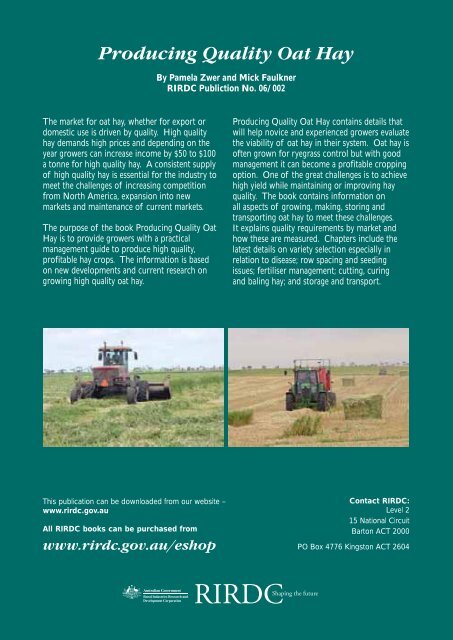Create successful ePaper yourself
Turn your PDF publications into a flip-book with our unique Google optimized e-Paper software.
<strong>Producing</strong> <strong>Quality</strong> <strong>Oat</strong> <strong>Hay</strong><br />
The market for oat hay, whether for export or<br />
domestic use is driven by quality. High quality<br />
hay demands high prices and depending on the<br />
year growers can increase income by $50 to $100<br />
a tonne for high quality hay. A consistent supply<br />
of high quality hay is essential for the industry to<br />
meet the challenges of increasing competition<br />
from North America, expansion into new<br />
markets and maintenance of current markets.<br />
The purpose of the book <strong>Producing</strong> <strong>Quality</strong> <strong>Oat</strong><br />
<strong>Hay</strong> is to provide growers with a practical<br />
management guide to produce high quality,<br />
profitable hay crops. The information is based<br />
on new developments and current research on<br />
growing high quality oat hay.<br />
This publication can be downloaded from our website –<br />
www.rirdc.gov.au<br />
All RIRDC books can be purchased from<br />
www.rirdc.gov.au/eshop<br />
By Pamela Zwer and Mick Faulkner<br />
RIRDC Publiction No. 06/002<br />
<strong>Producing</strong> <strong>Quality</strong> <strong>Oat</strong> <strong>Hay</strong> contains details that<br />
will help novice and experienced growers evaluate<br />
the viability of oat hay in their system. <strong>Oat</strong> hay is<br />
often grown for ryegrass control but with good<br />
management it can become a profitable cropping<br />
option. One of the great challenges is to achieve<br />
high yield while maintaining or improving hay<br />
quality. The book contains information on<br />
all aspects of growing, making, storing and<br />
transporting oat hay to meet these challenges.<br />
It explains quality requirements by market and<br />
how these are measured. Chapters include the<br />
latest details on variety selection especially in<br />
relation to disease; row spacing and seeding<br />
issues; fertiliser management; cutting, curing<br />
and baling hay; and storage and transport.<br />
Contact RIRDC:<br />
Level 2<br />
15 National Circuit<br />
Barton ACT 2000<br />
PO Box 4776 Kingston ACT 2604

















